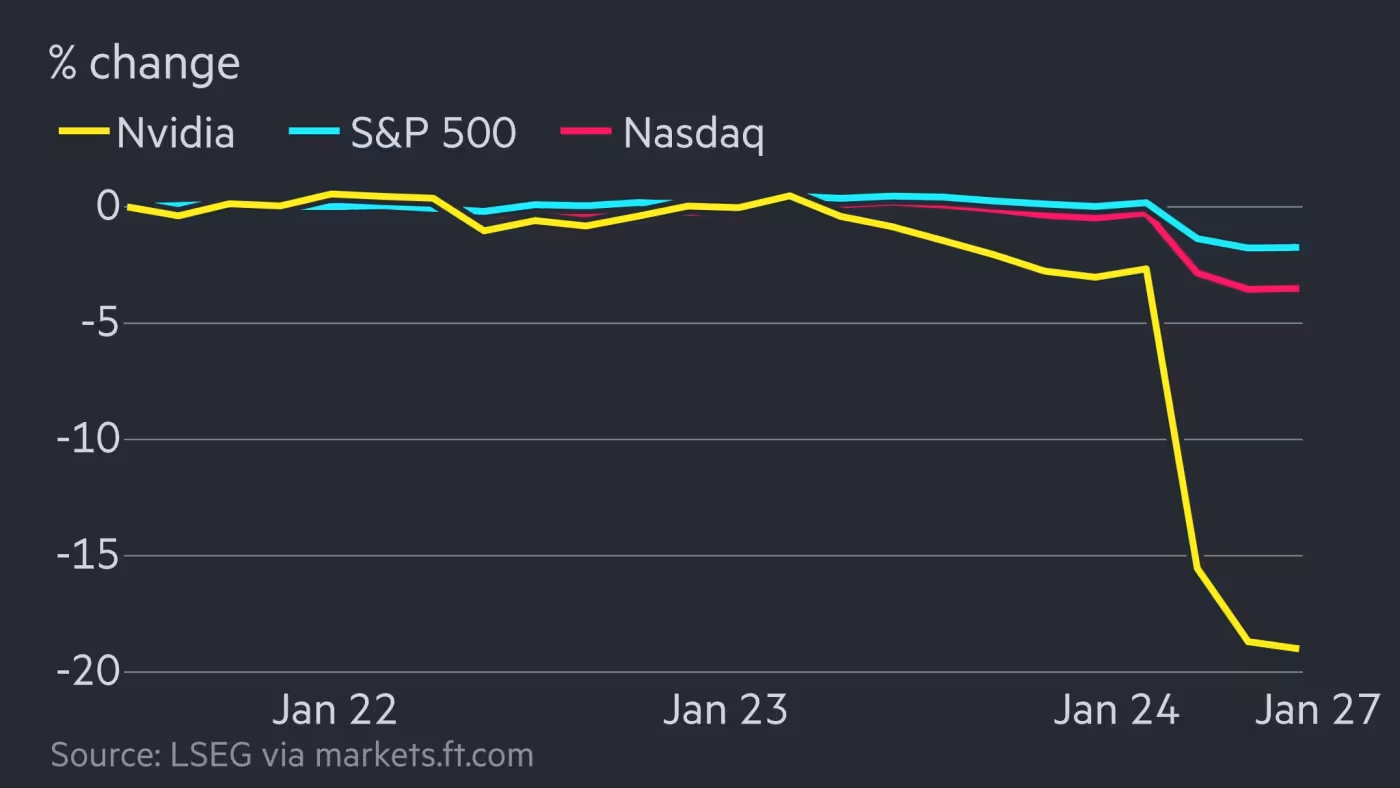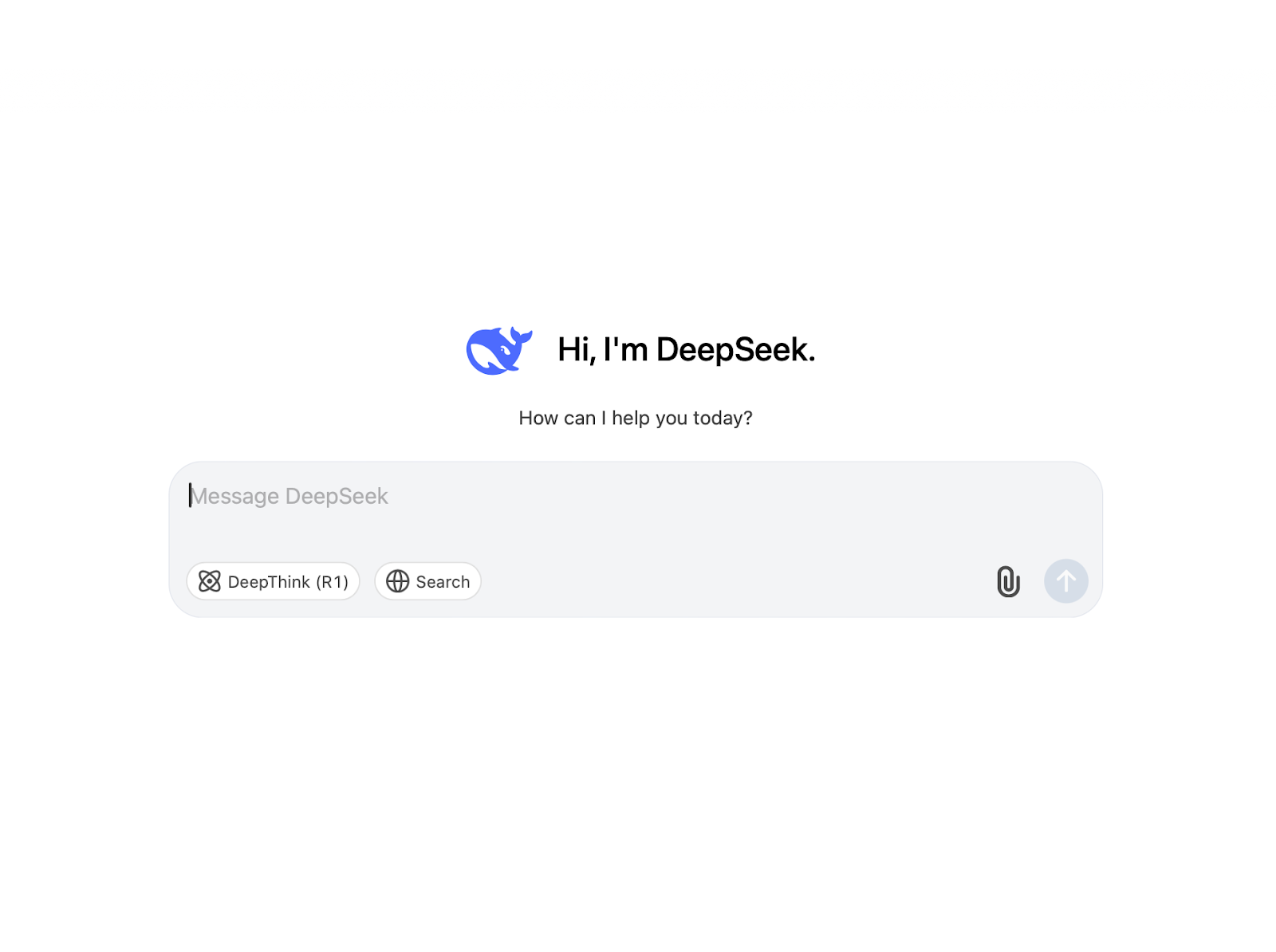ChatGPT vs. DeepSeek: The Space Race of AI?
Credit The Hill
On January 27th, panic overtook US tech companies as their stocks took one of the biggest tumbles in American history. Tech giants took a hit; renowned chipmaker Nvidia fell 18%, losing $589 billion in market value. However, Nvidia’s volatile shares recovered the next day by about 9%. The cause of these massive shifts in value: The announcement of DeepSeek, the Chinese hedge fund High-Flyer’s newest and most efficient AI chatbot.
Credit Financial Times
DeepSeek immediately made waves in the AI community. Claiming that the training of DeepSeek-V3 required less than $6 million worth of computing power from Nvidia H800 chips, the chatbot garnered global attention. This release is emblematic of the attention surrounding the release of ChatGPT in 2022, which had Chinese tech firms working overtime to release their own version of a chatbot powered by artificial intelligence (AI).
Back in 2022, the Bureau of Industry and Security of the United States Department of Commerce implemented greater export control as a response to these new AI development attempts in order to keep ChatGPT in the lead. The Department of Commerce aimed to prevent US businesses from exporting their chips to Chinese manufacturers and protect US tech advancement. Still, when Chinese search engine company Baidu released its first equivalent to ChatGPT, people were widely disappointed. The two platforms had largely different capabilities, leading users to stick with ChatGPT. Since Baidu’s AI release in 2023, numerous other Chinese companies have released their own AI models. But until now, the US hasn’t hailed any as equivalent models to ChatGPT. Until DeepSeek.
DeepSeek temporarily limited registrations after the AI assistant experienced a cyber attack, partially due to its exponential popularity in a few short hours after release. "Everyone was using it - DeepSeek became a top-rated free app available on Apple's U.S. App Store and the DeepSeek website experienced outages as users flooded the site. In recent days, the AI model is back online and working with few issues, DeepSeek continues to garner attention. But does DeepSeek warrant such a frenzy? There are some important differences between the two leading chatbots - ChatGPT and DeepSeek.
Cost for Training
DeepSeek: $5.6 Million over a several months
ChatGPT-4: Estimated $500 Million over several months
This cost difference for training is partly in ChatGPT’s larger 25,000 A100 GPU cluster (a massive computing infrastructure composed of 25,000 Nvidia A100 graphics processing units (GPUs) working together), higher operating costs, and more complex model training process, compared to DeepSeek’s 2,048 Nvidia H800 GPUs. However, there’s speculation that DeepSeek’s estimated cost is inaccurate, as a deeper analysis of its Total Cost of Ownership (TCO) - the complete cost of acquiring, operating, and maintaining an asset over its entire lifecycle - suggests that the actual cost for DeepSeek is closer to $110 million.
Core Functionality and Performance
The two models differ in functionality and interface capabilities. DeepSeek is great at coding, math, and logic-based tasks, providing precise and efficient answers. Its simple interface lacks chat memory or voice interaction though, making it feel more like a problem-solving tool than a conversational AI. ChatGPT 4o (the latest model) is more conversational and versatile, better at creative writing, brainstorming, and casual discussions, while still handling technical topics well. Its interface includes chat history, voice mode, and customization options, making it more interactive and user-friendly.
When testing the same prompt on both models, users have found they get similar responses. But DeepSeek’s answers seem to be more technical, while ChatGPT’s are generally a little more structured. It is also notable that the look of the interfaces is largely the same, and both offer English language. And good news for us students who seem to always be on a procrastination time-crunch: there’s no noticeable difference between the two in terms of speed.
Credit Fresh Van Root
Credit Fresh Van Root
Environmental Impact
In terms of environmental impact, DeepSeek is much more energy-efficient. Each prompt uses 0.003 kWh of energy and the training process (a multistage process for how an AI model learns from data to perform tasks) emits 50.5 metric tons of C02e. DeepSeek’s operation relies on Alibaba Cloud, which is China’s leading cloud provider. Alibaba Cloud’s data centers rely on China’s national power grid, which is primarily powered by coal, and this heavy reliance on coal results in high carbon emissions. Thus, transitions to renewable energy would mitigate the environmental impact from that. But in terms of energy efficiency, we may see less carbon emissions from the chatbot overall.
On the other hand, ChatGPT-4 uses 0.005 kWh of energy per prompt and has a much larger training footprint, emitting 552 metric tons of CO2e. Training requires vast computational power to process large datasets and optimize model parameters. ChatGPT’s operation relies on Microsoft’s Azure, a cloud computing platform. Microsoft has a goal to reach a carbon-negative status by 2030, and it’s consequently heavily investing in several renewable energy initiatives. But, a lot of data centers rely on traditional non-renewable sources, like coal and natural gas. Considering how chips used for AI are extremely resource-intensive, needing specialized hardware and lots of energy for their massive data processing needs, these initiatives may take time to reach their full intended effect.
As we can see, DeepSeek’s training footprint is noticeably smaller than ChatGPT’s. And because AI models need a lot of energy, DeepSeek may be a promising alternative for eco-conscious users. It may also be a wake-up call for US tech companies to tweak their research and development to be more environmentally friendly. But there’s more than just environmental impact to consider.
Accessibility
In terms of accessibility, DeepSeek is completely free to use online through a browser or on a mobile app. The chatbot charges 14 cents per million tokens at its most basic level, which is the cost of using its service. For some context, tokens are like pieces of words. Before a model’s API - Application Programming Interface - processes the request made by a user, what the user inputted is broken down into tokens. Tokens aren’t cut up exactly where the user’s text starts or ends, but can break text down into smaller portions for a model to read.
ChatGPT also offers a free online version, which is highly accessible and can answer basic prompts.. But, OpenAI has a lot of pricing plans. The paid personal plan for $20/month, and ChatGPT Pro for $200/month, offer a lot more features, and many users say they’re more capable in answering more complex prompts. OpenAI also charges $7.50 per million tokens for the o1 model.
Governance and Ethical Considerations
DeepSeek operates within China’s national regulations, raising questions about potential compromises in data privacy of American users and clear adherence to ethical standards. Could DeepSeek be Tiktok all over again? However, ChatGPT and OpenAI stick to broader international regulations, but also face scrutiny about data privacy. The ChatGPT platform operates under U.S. regulations and could be more easily monitored for privacy breaches.
But no matter the chatbot, we should all be careful about what we input into an AI model. With DeepSeek, Americans may feel inclined to exert extra caution if asking anything professional or sensitive due to its governance by a different country. But these cautions should be observed for all interfaces.
The rise of DeepSeek creates a historical shift in the AI landscape—one that challenges the long-standing dominance of US-based AI firms like OpenAI. While ChatGPT has a more user-friendly interface, is conversational, and a widely-familiar AI model, DeepSeek’s efficiency, affordability, technical precision, and environmental impact make it a genuine alternative to consider. However, the AI space race isn’t just about who has the better chatbot—it’s about innovation, accessibility, ethical governance, and sustainable improvements. DeepSeek’s existence shows the world that high-performing AI can still be developed with less money and less advanced chips, potentially making advanced AI more affordable and sustainable, giving US tech companies something to consider when potentially creating the next ChatGPT model. But questions around data privacy, scalability and smooth operation, and regulatory oversight are extremely important to consider. As AI continues to evolve, the competition between ChatGPT and DeepSeek may only be the start to many more years of competitive innovation. As global investment in artificial intelligence grows, both companies and users could benefit from more efficient, sustainable, and ethical AI platforms. And it’s also up to both the companies and users to act based on what they prioritize. The question now is: how will companies, governments, and users evolve alongside AI?




